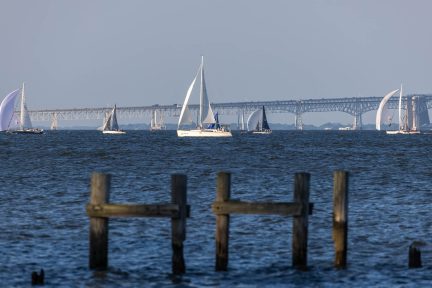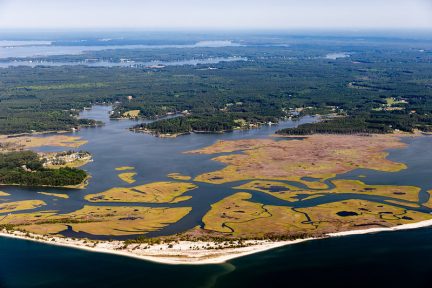Bay Program model shows decline in nutrient, sediment pollution entering the Chesapeake
Estimated nitrogen reductions coming from agricultural sector
Today, the Chesapeake Bay Program announced that the amount of nitrogen, phosphorus and sediment pollution entering the Chesapeake Bay in 2021 decreased from the previous assessment period. Each year, the seven watershed jurisdictions—Delaware, Maryland, New York, Pennsylvania, Virginia, West Virginia and the District of Columbia—report the practices they have implemented to decrease the amount of pollution entering the Chesapeake Bay.
Water quality in the Chesapeake Bay and its tidal tributaries is heavily influenced by nitrogen, phosphorus and sediment pollution delivered from the watershed and can vary year-to-year due to numerous factors including best management practices, land use, fertilizer and manure use, wastewater and septic discharges, and river flow.
Computer simulations show that between 2009—the Chesapeake Bay Total Maximum Daily Load (Bay TMDL) baseline—and 2021:
- Overall nitrogen decreased 14%, from 297.8 million pounds in 2009 to 257.53 million pounds in 2021, meeting 49% of the goal to reduce nitrogen by 2025.
- Overall phosphorus decreased 14%, from 17.2 million pounds in 2009 to 14.7 million pounds in 2021, meeting 64% of the goal to reduce phosphorus by 2025.
- Overall sediment decreased 4%, from 18.9 billion pounds in 2009 to 18.1 billion pounds in 2021, meeting 100% of the goal to reduce sediment by 2025.
Over the past year, it was determined that 77% of nitrogen reductions came from the agricultural sector. Declines in phosphorus and sediment pollution came primarily from the natural (forests, scrub and brush, stream beds and banks, wetlands and shorelines) and agricultural sectors. While historically, nitrogen and phosphorus reductions have come from the wastewater sector, in 2021, nitrogen and phosphorus entering the Bay actually increased in the wastewater sector, mainly due to permit violations at select Maryland wastewater facilities.
Facts
The seven watershed jurisdictions, in coordination with local governments, businesses, non-governmental organizations and individuals have installed pollution-reducing best management practices to lower the amount of nitrogen, phosphorus and sediment entering tributaries of the Chesapeake Bay.
The conservation practices reported by the seven watershed jurisdictions, along with land use, manure and fertilizer information, are entered into a sophisticated suite of modeling tools to estimate the progress that each jurisdiction is making in meeting their individual nitrogen, phosphorus and sediment goals as outlined in the Bay TMDL.
Through the Chesapeake Bay Watershed Agreement, the Chesapeake Bay Program has committed to having 100% of pollution-reducing practices in place that would achieve all of the nitrogen, phosphorus and sediment reductions necessary to meet the goals outlined in the Bay TMDL by 2025. These estimates are generated by the Chesapeake Bay Watershed Model and are derived from land use data, implementation and effectiveness of best management practices and water quality monitoring data. The Chesapeake Bay Program assesses water quality by the amount of dissolved oxygen in the Bay, chlorophyll a (a measure of algae growth) and water clarity (using underwater grass acreage).
The Environmental Protection Agency (EPA) uses the modeled nitrogen, phosphorus and sediment pollution estimates to evaluate whether jurisdictions are on track to meet the Bay TMDL reduction goals and their associated two-year milestone commitments. The EPA anticipates that it will release its evaluations of the 2020-2021 two-year milestones in July 2022.
Computer simulations show the following jurisdiction-specific breakdown of overall pollution reductions between 2009 and 2021:
- In Delaware, reported pollution controls achieved 20% of the 2025 reduction goal for nitrogen, 52% of the reduction goal for phosphorus and 63% of the reduction goal for sediment. The state did not meet its 2021 pollution reducing targets for nitrogen, phosphorus and sediment.
- In the District of Columbia, reported pollution controls achieved 100% of the 2025 reduction goals for nitrogen, phosphorus and sediment.
- In Maryland, reported pollution controls achieved 58% of the 2025 reduction goal for nitrogen, 74% of the reduction goal for phosphorus and 100% of the reduction goal for sediment. The state did not meet its 2021 pollution reducing targets for nitrogen and phosphorus but did meet its target for sediment.
- In New York, reported pollution controls achieved 69% of the 2025 reduction goal for nitrogen, 76% of the reduction goal for phosphorus and 21% of the reduction goal for sediment. The state did not meet its 2021 pollution reducing target for each of its 2021 pollution reducing targets.
- In Pennsylvania, reported pollution controls achieved 22% of the 2025 reduction goal for nitrogen, 48% of the reduction goal for phosphorus and 45% of the reduction goal for sediment. The Commonwealth did not meet its 2021 pollution reducing targets.
- In Virginia, reported pollution controls achieved 75% of the 2025 reduction goal for nitrogen, 68% of the reduction goal for phosphorus and 100% of the reduction goal for sediment. The Commonwealth did not meet its 2021 pollution reducing targets for nitrogen and phosphorus but met its target for sediment.
- In West Virginia, reported pollution controls achieved 100% of the 2025 reduction goal for nitrogen, 97% of the reduction goal for phosphorus and 100% of the reduction goal for sediment. The state has met each of its 2021 pollution reducing targets.
Issues
Excess nitrogen, phosphorus and sediment are among the leading causes of the Bay’s poor health. Nitrogen and phosphorus can fuel the growth of algae blooms that lead to low-oxygen “dead zones” that negatively impact marine life. Sediment can block sunlight from reaching underwater grasses, suffocating shellfish that rely on them for their habitat.
Pollution reducing practices used in backyards, in cities and on farms can reduce the flow of nitrogen, phosphorus and sediment into waterways. Management actions taken to decrease pollution from point sources (e.g., wastewater treatment plants) may immediately show detectable changes, but regarding the implementation of conservation practices for non-point sources (e.g., runoff that may include excess fertilizer or toxics), there is often a delay in measuring their impact on improving water quality and the health of the Bay.
Importance
By incorporating the best available data into our computer simulations and pollution load estimates, the Chesapeake Bay Program can more accurately track our partners’ progress toward their pollution-reducing goals. Assessing the progress that each jurisdiction is making toward reducing nitrogen, phosphorus and sediment pollution entering not only the Chesapeake Bay, but also their local waterways, gives us a more holistic view of how conservation practice installation and improved management actions are helping to improve Bay water quality.
Quotes
“The takeaway from this data shows that overall, the Bay states are stepping up and making an impact, especially in the agriculture sector. This momentum will help us take on the emerging challenges of climate change and the need to do more to engage disadvantaged communities.”
- Adam Ortiz, Regional Administrator, U.S. Environmental Protection Agency Mid-Atlantic Region
“Chesapeake Bay Program partners continue to install practices that demonstrate a steady reduction in the nutrient and sediment pollution that enters the Chesapeake Bay. Across the watershed the 2025 target for sediment is already achieved and the seven jurisdictions, with local partner support, are also making progress to reduce both nitrogen and phosphorus to attain the 2025 targets. As a partnership, we should build upon our current successes, focus our efforts on what works well, and pick up our implementation pace as we get closer to 2025.”
- Ed Dunne, Co-Chair of the Water Quality Goal Implementation Team and Chief, Standards and TMDL Branch, Water Quality Division, Department of Energy and Environment, District of Columbia
"New York's primary focus is to address local water quality issues through best management practice implementation. Even though we are far from the Bay, every practice implemented provides nutrient and sediment reduction benefits, locally and downstream to the Chesapeake Bay. While NY has made great progress towards meeting our Chesapeake Bay TMDL goals, we still have a ways to go. We continue to seek out additional funding opportunities for our farmers and landowners to assist with practice implementation costs, making high quality and larger scale projects more feasible."
- Emily Dekar, Member, Chesapeake Bay Program Agriculture Workgroup and Agricultural Coordinator, Upper Susquehanna Coalition



